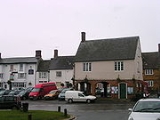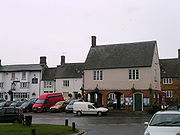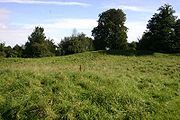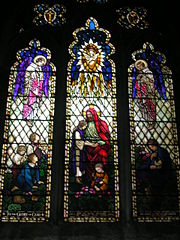
Deddington
Encyclopedia

Oxfordshire
Oxfordshire is a county in the South East region of England, bordering on Warwickshire and Northamptonshire , Buckinghamshire , Berkshire , Wiltshire and Gloucestershire ....
about 6 miles (10 km) south of Banbury
Banbury
Banbury is a market town and civil parish on the River Cherwell in the Cherwell District of Oxfordshire. It is northwest of London, southeast of Birmingham, south of Coventry and north northwest of the county town of Oxford...
. In scale Deddington is a village, but it has a town centre with a market place and the local football team is called Deddington Town FC.
History

Anglo-Saxons
Anglo-Saxon is a term used by historians to designate the Germanic tribes who invaded and settled the south and east of Great Britain beginning in the early 5th century AD, and the period from their creation of the English nation to the Norman conquest. The Anglo-Saxon Era denotes the period of...
nobleman, and means "the place of the people of Daeda". The village is believed to have been first settled in the 6th or 7th century AD.
After the Norman conquest of England
Norman conquest of England
The Norman conquest of England began on 28 September 1066 with the invasion of England by William, Duke of Normandy. William became known as William the Conqueror after his victory at the Battle of Hastings on 14 October 1066, defeating King Harold II of England...
in 1066, William the Conqueror's step-brother Odo, Bishop of Bayeux, held the manor
Manorialism
Manorialism, an essential element of feudal society, was the organizing principle of rural economy that originated in the villa system of the Late Roman Empire, was widely practiced in medieval western and parts of central Europe, and was slowly replaced by the advent of a money-based market...
of Deddington. Odo had Deddington Castle
Deddington Castle
Deddington Castle was in the large village of Deddington 6 miles south of Banbury, Oxfordshire .It was built on a Saxon site as a motte and bailey castle in the 11th century by Bishop Odo of Bayeux, the half brother of William the Conqueror...
built in what is now the east of the town. The castle was almost completely demolished in the 14th century. There have been two archaeological excavations
Archaeology
Archaeology, or archeology , is the study of human society, primarily through the recovery and analysis of the material culture and environmental data that they have left behind, which includes artifacts, architecture, biofacts and cultural landscapes...
at the site, in 1947 and in 1978. The remains were recovered once the excavations were complete and only the extensive earthworks are visible today.
On 9 June 1312 the Earl of Pembroke
Aymer de Valence, 2nd Earl of Pembroke
Aymer de Valence, 2nd Earl of Pembroke was a Franco-English nobleman. Though primarily active in England, he also had strong connections with the French royal house. One of the wealthiest and most powerful men of his age, he was a central player in the conflicts between Edward II of England and...
was escorting Piers Gaveston
Piers Gaveston
Piers Gaveston, 1st Earl of Cornwall was an English nobleman of Gascon origin, and the favourite of King Edward II of England. At a young age he made a good impression on King Edward I of England, and was assigned to the household of the King's son, Edward of Carnarvon...
south after Gaveston's surrender to a group of rebellious earls at Scarborough Castle
Scarborough Castle
Scarborough Castle is a former medieval Royal fortress situated on a rocky promontory overlooking the North Sea and Scarborough, North Yorkshire, England...
. The party stopped to rest at an inn
INN
InterNetNews is a Usenet news server package, originally released by Rich Salz in 1991, and presented at the Summer 1992 USENIX conference in San Antonio, Texas...
in Deddington, and Pembroke who had guaranteed Gaveston's safety to the king on pain of forfeiting his lands, went to visit his wife at Brampton in Northamptonshire
Northamptonshire
Northamptonshire is a landlocked county in the English East Midlands, with a population of 629,676 as at the 2001 census. It has boundaries with the ceremonial counties of Warwickshire to the west, Leicestershire and Rutland to the north, Cambridgeshire to the east, Bedfordshire to the south-east,...
. The Earl of Warwick
Guy de Beauchamp, 10th Earl of Warwick
Guy de Beauchamp, 10th Earl of Warwick was an English magnate, and one of the principal opponents of King Edward II and his favourite Piers Gaveston. Guy de Beauchamp was the son of William de Beauchamp, the first Beauchamp earl of Warwick, and succeeded his father in 1298...
with his men surrounded the inn and Gaveston, seeing that his guards would not fight, had to come outside to be chained and thrown in prison. Warwick, whom Gaveston had earlier called black cur (black dog), a serious insult at that time, had now bitten him. A few days later Gaveston, who had been appointed Earl of Cornwall by the king was taken to Warwick
Warwick
Warwick is the county town of Warwickshire, England. The town lies upon the River Avon, south of Coventry and just west of Leamington Spa and Whitnash with which it is conjoined. As of the 2001 United Kingdom census, it had a population of 23,350...
to be tried by the other earls and condemned to death. On June 19 he was taken to Blacklow Hill by the Earl of Lancaster and hacked to death by two Welshmen. This event is recalled by a chained eagle in Deddington's coat of arms.
The Banbury Historical Society has published the diary of the Rev William Cotton Risley who was Vicar of Deddington from 1835 - 1848.
Churches

Church of England parish church
A parish church in the Church of England is the church which acts as the religious centre for the people within the smallest and most basic Church of England administrative region, known as a parish.-Parishes in England:...
of St. Peter and St. Paul
Feast of Saints Peter and Paul
The Feast of Saints Peter and Paul, or the Solemnity of Saints Peter and Paul, is a liturgical feast in honour of the martyrdom in Rome of the apostles Saint Peter and Saint Paul, which is observed on 29 June...
date from the early 13th century. The church once had a tall spire
Spire
A spire is a tapering conical or pyramidal structure on the top of a building, particularly a church tower. Etymologically, the word is derived from the Old English word spir, meaning a sprout, shoot, or stalk of grass....
but it collapsed onto the nave
Nave
In Romanesque and Gothic Christian abbey, cathedral basilica and church architecture, the nave is the central approach to the high altar, the main body of the church. "Nave" was probably suggested by the keel shape of its vaulting...
in 1634, rendering it unusable for several years. The present tower has a ring
Change ringing
Change ringing is the art of ringing a set of tuned bells in a series of mathematical patterns called "changes". It differs from many other forms of campanology in that no attempt is made to produce a conventional melody....
of eight bells, six cast
Bellfounding
Bellfounding is the casting of bells in a foundry for use in churches, clocks, and public buildings. A practitioner of the craft is called a bellmaker or bellfounder. The process in Europe dates to the 4th or 5th century. In early times, when a town produced a bell it was a momentous occasion in...
in 1791 and two added in 1946. There are stained glass windows by Charles Kempe and A.J. Davies.
Deddington Wesleyan Reform Church was built in 1851 and is a member of the Wesleyan Reform Union
Wesleyan Reform Union
The Wesleyan Reform Union is an Independent Methodist Connexion based in the United Kingdom. It was founded in 1859 by the members of the Wesleyan Reform movement who did not join the United Methodist Free Churches-Statement of Faith:...
.
Old Court House
The Old Court House was a private home until 1854, when the architect J.C. BucklerJohn Chessell Buckler
John Chessell Buckler was a British architect, the eldest son of the architect John Buckler. J.C. Buckler initially worked with his father before working for himself. His work included restorations of country houses and at the University of Oxford.-Career:Buckler received art lessons from the...
converted it into a prison. The architect William Wilkinson
William Wilkinson (architect)
William Wilkinson was a British Gothic Revival architect who practised in Oxford, England.-Family:Wilkinson's father was a builder in Witney in Oxfordshire. William's elder brother George Wilkinson was also an architect, as were William's nephews C.C. Rolfe and H.W. Moore .-Career:Wilkinson...
added the magistrates' room in 1874. The building now houses the local public library.
Schools
From 1673 Deddington had a charity school "in a corner of the church". In 1815 separate boys' and girl's National SchoolsNational school (England and Wales)
A national school was a school founded in 19th century England and Wales by the National Society for Promoting Religious Education.These schools provided elementary education, in accordance with the teaching of the Church of England, to the children of the poor.Together with the less numerous...
were founded to take over from the charity school. By 1816 the two schools were teaching 35 children between them, including about 20 from neighbouring parishes. By 1832 the school was housed in converted buildings, including a barn, attached to Appletree Farm in Hopcraft Lane.
Support for Deddington's National Schools declined until in 1848 they had only 80 pupils between them. Purpose-built boys' and girls' school buildings were designed by William Hambley of London and completed in 1854 on a new site in Banbury Road. The two schools were an immediate success and pupil numbers recovered to 180 by 1856. Attendance varied with the seasons, as in summer farm-workers' children tended to help more on the farm. In 1868, 247 children attended the school in winter but only 191 in summer. Boys and girls remained in separate schools on the same site until 1908, when the girls' school became the infants' school and the boys' school became a mixed school for the older children.
In 1951 the Windmill Secondary Modern School
Secondary modern school
A secondary modern school is a type of secondary school that existed in most of the United Kingdom from 1944 until the early 1970s, under the Tripartite System, and was designed for the majority of pupils - those who do not achieve scores in the top 25% of the eleven plus examination...
was completed on the site of the former windmill in Hempton Road and the former National School was reorganised as a primary school. In 1958 the Diocese of Oxford
Diocese of Oxford
-History:The Diocese of Oxford was created in 1541 out of part of the Diocese of Lincoln.In 1836 the Archdeaconry of Berkshire was transferred from the Diocese of Salisbury to Oxford...
modernised the primary school with a new kitchen, cloakrooms, WCs, corridor, a new classroom and enlarged windows for the old classrooms. The modernisation was designed by the Diocesan Surveyor, the architect T. Lawrence Dale
T. Lawrence Dale
Thomas Lawrence Dale, FRIBA, FSA was an English architect. Until the First World War he concentrated on designing houses for private clients...
.
In 1971 the Windmill School was closed, and since then most Deddington children of secondary school age have attended The Warriner School, Bloxham
The Warriner School, Bloxham
The Warriner School is a secondary school which opened in 1971 and is situated on the Bloxham Road in Bloxham, Oxfordshire. The school has 1,114 pupils in the 11–16 range. It has Technology College status and serves the villages in the northern half of the Cherwell District...
. The former secondary school is now the Windmill Centre and is used by Deddington Pre-School. Deddington Primary School continues to use the buildings in Banbury Road.
Amenities
Deddington has a regular farmers' marketFarmers' market
A farmers' market consists of individual vendors—mostly farmers—who set up booths, tables or stands, outdoors or indoors, to sell produce, meat products, fruits and sometimes prepared foods and beverages...
, several local shops, hotels and restaurants and four pubs:
- The Crown and Tuns (Hook Norton BreweryHook Norton BreweryHook Norton Brewery is a regional brewery in Hook Norton, Oxfordshire, England, founded in 1849. The brewing plant is a traditional Victorian "tower" brewery in which all the stages of the brewing process flow logically from floor to floor; mashing at the top, boiling in the middle, fermentation...
) - The Deddington Arms Hotel
- The Red Lion Bar and Bistro
- The Unicorn Inn
External links
- Deddington Online – comprehensive parish website
- The Deddington News – news and current affairs for Deddington, Clifton and Hempton
- British Microlight Aircraft Association (BMAA) – HQ in Deddington

